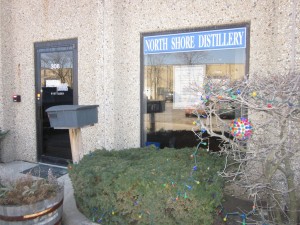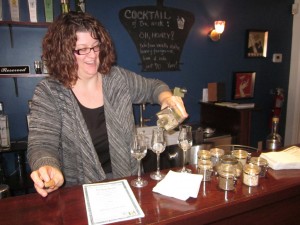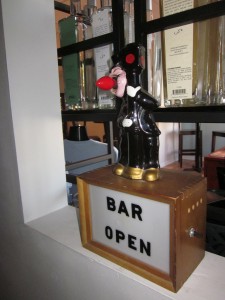by Katje Sabin (mamagotcha)
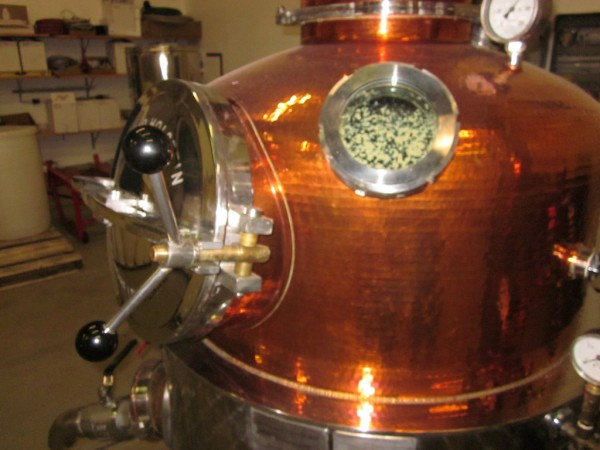
Tucked in a cluster of small industrial buildings between a freeway and a field, amid loading docks and drainage ponds, is a tiny storefront with a half-barrel of herbs and cheerful little holiday lights in front. Just off I-94 in Lake County, about 28 miles north of O’Hare, you’ll find the tasting room and production facility of North Shore Distillery, Illinois’ very first post-Prohibition maker of hand-crafted spirits.
I climbed out of the car and listened to trucks downshifting in the distance, with a counterpoint of small birds happily celebrating the fact that they’ve just survived Chicago’s worst winter in recorded history. I walked across the asphalt under the weak spring sunshine, not sure what to expect: a rickety Rube Goldberg-style tangle of pipes and flasks? Big oak barrels and good ol’ boys in trucker caps and overalls? A brisk and businesslike sterile laboratory? I am clueless, but North Shore Distillery’s co-owner Sonja Kassebaum has kindly offered to educate me in the ways of small-batch distilling, and I’m reporting for my first (and only) day of class.
The Story of North Shore Distillery
I’m greeted by the waft of a gentle yeasty scent, more bread-like than boozy. The entry leads into a warm and welcoming tasting room that has the demeanor of a bright and cheery pub. A wooden bar flanked by tasting menus dominated the room, and several tall tables and stools are scattered throughout the space. Sonja approached me with a big grin and a warm handshake; she is more scholar than mad scientist or industrial worker, and I relaxed.
I asked how she and her husband, Derek, found themselves together on this path. She told me, “We met on a gaming BBS called Outer Limits in Denver, Colo. I was a math major and we were introduced by a mutual friend because Derek was looking for math help. Two and a half months later, we got married. We have a bit of an impulsive streak, once we decide to do something!” They’ve been married for 22 years now.
She explained, ”We’ve always been spirits people. I’m allergic to wines, so we moved to spirits earlier than most people do. You do shots and rum and Coke when you’re young, but not cocktails. We’d go to the liquor store and look for new and interesting things. I would look at them and wonder ‘What do I do with that?’, while Derek would wonder ‘How do I make that?’. He’s a chemical engineer by training; how and why things go together is his focus. I’m a lawyer; I was the head of HR at a consulting firm.”
RECIPES:
In 2003, Derek started to research the idea of distilling his own spirits, and the company was formed on October 1, 2004. They ordered their still from a custom manufacturer in Germany, and it arrived in early 2005. Sonja quit her job that July. They spent the summer refining their recipes, and their first sales were in October of 2005.
The still (her name is Ethel) arrived in a huge wooden crate, in three pieces, with no instructions, other than a few notes in German – a language which neither Kassebaum speaks. But Derek had visited Germany to inspect the still at the factory, and he was able to figure out how to put it together himself. “He’s handy to have around,” Sonja said.
The Distillery Business Today
”You can only distill water before you have a license,” Sonja explained. “When we applied (for a license), there were only a few craft distilleries out there: 60 in the U.S. But after 10 years, it’s up to 600. It’s an interesting time to be in the business. We were the first craft distillery in Illinois.” There are 20 now, and five more due online in the next six to nine months. Sonja knows this because she’s the secretary of the newly minted Illinois Craft Distillers Association.
This is a marked change from pre-Prohibition (1920-1933) days, when, Sonja said, there were 1,000 distilleries in Kentucky alone. “There used to be local spirit producers everywhere. It was part of the fabric of our country,” she said. She likens the distilleries of the past to the modern locavore movement; each area had its own specialties and products.
But given today’s landscape, in which small distilleries are trying to gain a foothold in the market again, could too many local ones make things too competitive? No, she said. “We’re better off working together; a rising tide raises all ships. There’s room for all of us. Not all feel that way, but many do.”
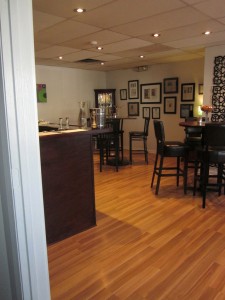
And cooperation between distilleries can be helpful in an industry that is so regulated, convoluted, and expensive. She said, ”We pay taxes every two weeks. We must account for every drop. Some rules are holdovers from Prohibition. Some are from the belief that spirits are more sinful or evil than beer and wine, so the taxes are higher…sin taxes.”
Sonja noted that this archaic view of the art of distilling affects more than just the money aspect of her business. She pointed out a small bottle with old-looking writing on it, a gift from a friend: ”This was juniper extract, the number one-selling item in the Sears catalog during Prohibition. It was how you flavored bathtub gin.”
Today, she noted, ”you can make beer or wine at home but it’s a felony to distill. There’s a push to change this law, but it won’t happen anytime soon. The only place where it’s legal to distill at home is New Zealand.”
Developing the Recipe for Success
I asked her about how they settled on this space in a rather nondescript area. “What we do is flammable, so it had to be in an industrial site. We wanted to be close to the North Shore, but there’s not a lot of industrial property,” she explained. “We met with village councils; some village ordinances forbid distilling, but Lake Bluff was pretty flexible. The tasting room MUST be co-located with the production facility, and we MUST live in the county where the license is.”
They had to obtain their equipment first before applying for their licenses. They rented the facility, redid the plumbing and electricity, and then installed their custom German still: ”There were no other distilleries in Illinois at the time. It was like we were training the people who were processing our application. Nobody had seen anything like us before, but we were politely persistent. A distillery generates tax revenue, but they wanted to make sure we knew what we were doing. It took six months: five for the federal license and one for the state. That was actually pretty fast; other distilleries took longer.”
Derek and Sonja immediately began creating recipes and tinkering with them. “Derek went to some classes on similar stills, but until you work on your own, you don’t know how to do it,” Sonja said. North Shore Vodka and Distiller’s Gin No. 6 were the first spirits they produced. They made them over and over, partly to evaluate their methods and partly to train their palates. “We’d have parties that are still talked about in our neighborhood,” said Sonja. “Anyone we knew who was a gin drinker, we would do blind taste tests including commercial gins. No. 6 was always the favorite.”
All the herbs in North Shore Distillery’s products are organic and wild-harvested, and the Kassebaums needed to be certain that their sources were consistent and reliable. For No. 6, “We knew we wanted a bright citrus note, and used fresh lemon peel for that. Gin must have juniper to be gin. We tried junipers from all over the world, and found the domestic ones to be bitter and medicinal. We settled on an Eastern European juniper. We wanted some detectable spike tones, and used cardamom, coriander and cinnamon. We got a floral note with lavender. It’s just like developing any other recipe,” she said.
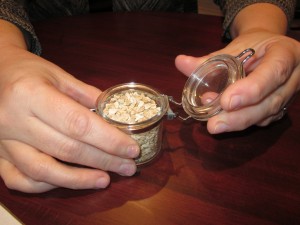
She brought over a little bottle of whitish woody chips, and explained that it was orris root, the root of an iris. It’s used in gin and perfume, as a base note for the middle and top notes to balance against – but if you use too much, it tastes like dirt. “We definitely made some things that were deliberately disgusting. We’ve got to be sure we know the difference so we don’t put out anything gross. That’s part of the fun!” she said.
I asked if they used any local products, and she said, “We do when it makes sense. For instance, Nielsen-Massey Vanilla in Waukegan is the best vanilla out there.” They also use local produce, herbs, and syrups in their cocktails.
Sometimes they make a single-batch spirit (the next one is due out this month, but it’s a big secret and no amount of wheedling garnered even a hint). Past single-batch flavors have included Ceylon tea, medjool dates, rhubarb, mango, molé poblano, and Silver Lining, a coffee-chocolate Kräuter liqueur (a German herbal liqueur better known as Jaegermeister – “We make Jaeger for grown-ups!” Sonja quipped).
She offered to let me taste a few of their products, and I gladly accepted. Sonja didn’t join me in imbibing, though: “Drinking is a bit of an occupational hazard, so I give my liver one day of rest each week.”
Taste Test
She started with the gins. North Shore Distillery’s flagship product is the Distiller’s Gin No. 6, what Derek and Sonja consider their modern gin, aromatic and complex with flavors of juniper, citrus, spice and floral notes. It’s the highest-rated American-made gin, and received 95 points from the Beverage Testing Institute. When I asked about the almost creamy mouthfeel, she explained that the essential oils from the herbs give body and texture to the spirits. This is why this gin felt smoother to me than the next two, because No. 6 had more of those herbs. “Some spirits have additives to change the texture. Not us!” Sonja said.
Distiller’s Gin No. 11 is their classic London dry gin, with more juniper. This one is better for the “old school” or savory cocktails, with less spice and no floral, Sonya told me. She also poured me a little of their Mighty Gin, a high-proof version of No. 6, with a flavor between No. 6 and No. 11; there’s more juniper but still a whiff of the florals, as well.
I sampled the straight North Shore Vodka (which tasted clean and smooth to me), the Sol Chamomile Citrus Vodka (fruity and light but not sweet), and the Tahitian Vanilla Vodka, which is currently only sold in the distillery’s tasting room (it’s creamy and slightly floral, with just the slightest touch of sweetness). Sonja said that it’s the only product they make that includes sugar, to extend the finish.
Aquavit–Private Reserve is poured ice cold, straight from the freezer. This product is probably why I asked for this particular writing assignment, and I’m happy to report that it’s still as spicy and savory as when I first tried it a year ago. There are hints of caraway and cumin and anise, with a depth that comes from aging in oak barrels. “It’s something we love. Scandinavian friends introduced us to it,” Sonja said.
Sirène Absinthe Verte is 120-proof and not meant to be drunk straight. Louche is the pale green turbulence or cloudiness that characteristically appears in absinthe when water is added, and Sonja was good at showing it off for me. Anise seed and fennel make it grassy and fresh, and the bitter wormwood is only a supporting player instead of hamming it up across the palate. It’s very herbal and complex. I liked it, and I don’t like absinthe; I may have to revisit my opinion.
Which one does Sonja like the best? She feigned horror when I asked. “We like them all! We only make things we like. That’s like asking us to pick a favorite child!” she said.
Ethel, the Still, and the Distilling Process
Now that I was properly warmed up, we moved into the production area where we met Sunshine, the distillery dog. Sunshine rose to greet us, and happily accompanied us on the rest of our tour.

Ethel, the North Shore still, commands your attention as soon as you walk into the big open area of the production floor. I’m a little surprised at how small she looked at maybe eight feet tall, considering she cranks out enough booze to supply several states with NSD products. She has a beautiful purplish patina over her gleaming copper dome, which was hand-hammered and shows no sign of a seam. “We give Ethyl a spa day periodically – a good cleaning and a polish,” Sonya said.
The lower half of the still is covered by a shining steel water jacket. Sonja said, “Most stills heat by steam, but ours is water. It’s gentler, like a double boiler, so it doesn’t cook the herbs. It gives us bright fresh flavors. It would be inefficient if we were making a million cases, but we’re not, so it’s okay.”
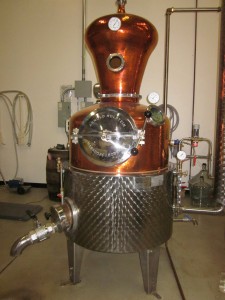
Here’s a quick introduction to the distilling process: Soaked grains (such as corn, barley, or rye) begin to sprout, which converts their stored starch into sugars. This sprouted grain is dried, crushed, and soaked in warm water with yeast (now you have “mash”). The yeast digests the sugar, which produces alcohol (this is fermentation). At this point, you have “wash” or “sour mash,” which is basically unhopped beer. The point of distilling is to concentrate and purify the alcohol out of this mess. This is where Ethel comes in.
Once she is filled up, the water jacket circulates warm water that slowly heats, causing the alcohol to become vapor that rises to the top of the still. This vapor is carried out via a pipe through a condenser, which cools that vapor back into a liquid and drains it into big glass carboys (those giant jugs that look like water cooler bottles).
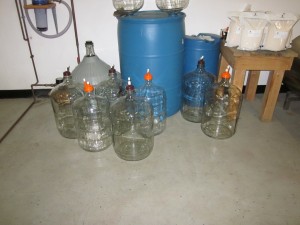
The initial distilling product is called the “heads,” and it is not anywhere ready for prime time. “It tastes and smells bad. There’s methanol, things you don’t want in there,” Sonja said, grimacing. As the temperature rises, you get to the “hearts,” the good stuff, eventually ending up at the “tails,” which are quite alcoholic and full of fusol oils (undesirable volatile liquids).
As the flavors change during distillation, the Kassebaums use Mason jars to taste the flavor of a new product throughout the process. It goes something like this: “Yuck, yuck, yuck, yuck, maybe, maybe, yum!” The Yucks (the heads and tails) will get discarded, and the narrow band of Yum (hearts) is collected and will be distilled again, and perhaps even a third time, before the final spirits are produced.
Out of about 60 gallons of mash, you’ll get maybe 10-15 gallons on the first, or “stripping,” run. You get to keep a little more out of the “finishing” or second run, which will subsequently be a higher proof. Some products rest or age at this point; resting can last as short as a week, but can sometimes take years. Sonja showed me wooden barrels of whiskey and rum aging on shelves, and told me that they did a single malt for St. Patrick’s Day this year.
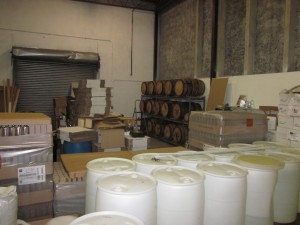
Then you must use water to bring the product to the exact approved proof for sale. For instance, vodka is about 60 percent water and about 40 percent alcohol, which gives you 80 proof. The gins are distilled a total of three times, with the flavoring herbs added on the last run. The final spirits are filtered, then bottled, corked, and labeled by hand. Finally, they are sealed, packed, and shipped. And the owners add a personal touch: “Derek still signs each bottle,” Sonja said.
Taking Care of Business
Today, NSD has two full-time and six part-time employees, in addition to the Kassebaums. The company is growing. In fact, they regularly get calls from distributors to expand their sales area and offers to partner with other businesses.
“It’s nice to be asked, but we don’t want to bite off more than we can chew,” Sonja said. “We want to make sure Chicago folks can find us, that we’re solid in our region. We ship to six states in the Midwest. Many distilleries are larger, but we’re a mom-and-pop shop. We’re not quite at capacity but we’re close.” Are they thinking about expanding down the road? “We’re considering a second stripping still, a bit bigger, someday,” she said.
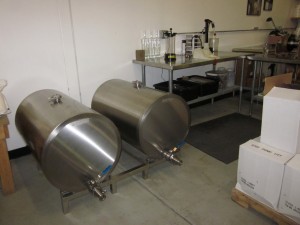
I rudely inquired as to how the business was doing financially, but the gracious Sonja took my nosiness in stride. “I can make more money as a lawyer, but it’s much more interesting and enjoyable doing this. We’re doing fine. We make payroll, and we’ve grown every year since we’ve opened.”
Crafting Cocktails!
Derek oversees all the aspects of production, while Sonja is in charge of sales, the tasting room, and events. It’s clear that, while Sonja is intimately familiar with the equipment and process of making their spirits, her passion is the craft of cocktails: “I blame it all on Ted Haigh, a.k.a. Dr. Cocktail (which is also a cocktail!). Before that, I was at the Mr. Boston level.” (She’s referring to the popular Mr. Boston bartending book.) “Mr. Boston doesn’t tell you the why or the origins of what you’re using, you don’t understand the alchemy of what happens in the glass. I didn’t fully internalize that until I got Haigh’s vintage cocktail book in 2003.”
“(Haigh) picks drinks that are good and surprising,” Sonja continued. “I made all of them. He tells you why and how and what he likes. It’s a whole other world!” Her delight with the art and craft of cocktails is infectious, and she loves to share her knowledge freely.
One way to keep up with her is to sign up for the North Shore Distillery’s newsletter and to follow her blog, Thinking of Drinking, which is due to relaunch with a brand new website this year.
When asked to name her favorite cocktail, one that she’ll bust out to show her chops for a special event, she demurred politely: “There’s no one knockout drink. I tailor every drink to each person’s tastes. Sometimes it’s fun to play, but you have to be informed by the classics first.” She seemed to be especially enamored by seasonal ingredients, and some of her recent favorites have included basil, blueberries, grapefruit, and rosemary. “We grow some of our cocktail herbs right here!” She pointed to the half barrel next to the tasting room door – gardening is another of her hobbies. But she admitted, “I do love a good martini.”
Sonja explained, ”I play with what we have, or I make a challenge: what about maple syrup and absinthe? I love Chartreuse, in a cocktail called The Last Word (equal amounts of gin, green Chartreuse, maraschino liqueur, and lime juice, shaken with ice). How about a Bloody Mary or an Old Fashioned made with aquavit? I love a good Negroni (one part each gin, vermouth rosso, and Campari bitters).” Her latest offering in the tasting room is NSD’s Tahitian Vanilla Vodka with honey tangerine juice, which sounds like the ultimate Creamsicle to me.
Her recommendation to home bartenders ready for the next step? She has two books she wants you to get your hands on:
• “Joy of Mixology” by Gary Regan – “It shows you patterns in drinks within categories, and non-biased reviews on tools and techniques.”
• “Vintage Spirits and Forgotten Cocktails: From the Alamagoozlum to the Zombie – 100 Rediscovered Recipes and the Stories Behind Them” by Ted Haigh (a.k.a. Dr. Cocktail) – “This book helps you see how all these crazy things come together.” (Full disclosure: Haigh actually contacted Sonja about her adventures as a cocktail blogger, and mentioned her in the newest edition of his book. She said, “This is much cooler than being immortalized in a hypothetical in a law school textbook, which is my only other known appearance in a book.”)
As I prepared to depart from my crash course in craft distilling, Sonja summed up North Shore’s outlook: “We have no regrets! Doing something like this, we learned so much about ourselves and each other. Some folks, it doesn’t work so well, but we have a lot of fun. If we’re not having fun, we’re not doing it right!”
Visiting North Shore Distillery
North Shore Distillery is open for tasting and sales Monday-Thursday, noon-6 p.m., and Friday-Saturday noon-9 p.m. The cocktail bar hours are Friday, 4-9 p.m. and Saturday, noon-9 p.m. Distillery tours are at 3 p.m. on Saturdays ($10 per person includes tastings; reservations are recommended).
On May 10 from 5-9 p.m., North Shore Distillery hosts its 1st Annual Artisan Producer Festival. Jo Snow Syrups, Hansa Coffee Roasters, Katherine Anne Confections and STILL – Spirited Bath & Body Care will be on hand to show off their wares and provide samples.
North Shore Distillery
28913 Herky Dr., Unit 308,
Lake Bluff, IL 60044
847-574-2499
tours@northshoredistillery.com
www.northshoredistillery.com


